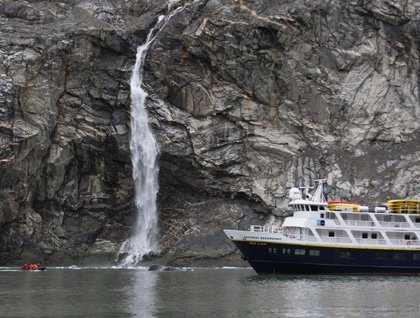Today we turned into one of Southeast Alaska’s most impressive fjords. All of Alaska is glacially carved, and so topography is typically impressive. But far into the Coast Range, glaciers have worked on hard granite and gneiss, producing an astonishing landscape. Above Tracy Arm, peaks soar to rounded heights thousands of feet above the tideline. Vertical cliffs bear deep gouges from the passage of the glacier’s stony belly. And waterfalls tumble from the heights like braided skeins of mountain goat wool.
Morning was dim, dreary and mysterious as we made our way up the fjord. Fog wrapped the hills and swaddled the water. The sea was like milky jade and icebergs began to appear. By breakfast the fog had lifted, revealing the entrance to Sawyer Glacier.
After eating, we hopped into our small boats to approach the glacier. We passed bergs sized like fists and like fields, looking like chunky gypsum, like gravelly loam, like beds of lava wrought in crystal. And at last the glacier. South Sawyer flows from the Stikine Icefield in two merging streams of craggy ice. The face of this glacier, standing as much as two hundred feet high, is beautiful. Here, ice under compression has air bubbles squeezed out, and so attains a deep glowing sapphire blue. We spent some time before the glacier, admiring its many aspects and trying to grasp the scale of the landscape around us. Some were lucky enough to see a couple of big calvings which filled the fjord with mighty rumblings and rocked our boats on huge swells. All of us enjoyed dainty but vociferous terns, and shy but curious seals.
In the afternoon we made our way back down Tracy Arm. Waterfalls were everywhere. We stopped at the “mouths” of two huge ones. At last we reached the wider and calmer-seeming landscape of Stephen’s Passage, where, at a slow cruise, we made our way toward Juneau and our trip’s conclusion.







